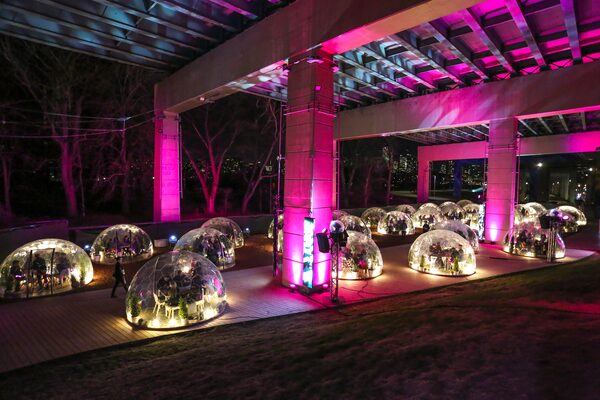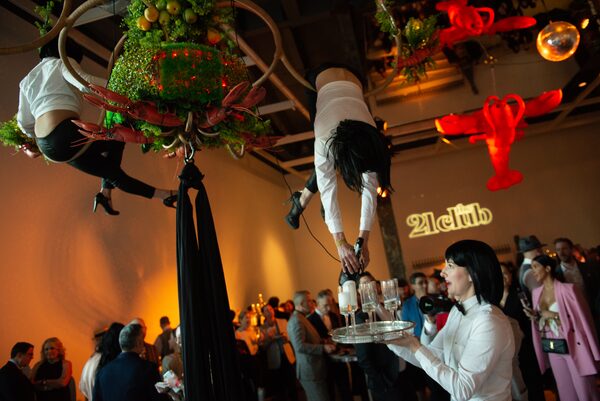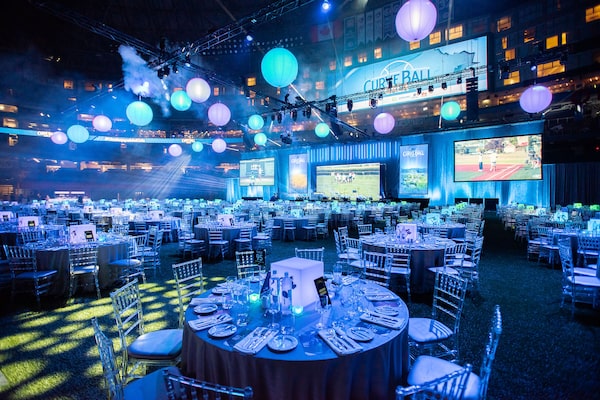
The Dinner with a View under Toronto's Gardiner Expressway.Handout
In late March, I had dinner in a tent under Toronto’s Gardiner Expressway. It was the media preview for Dinner With a View, a pop-up restaurant sponsored by American Express that was billed as “a completely luxurious dining experience” in a “wondrous environment perfect for sharing via social.” As I waited for my main course, I realized that, once again, I’d taken the bait and fallen for another over-hyped experience. The plants in my dome were plastic, my food and I were both cold and promoting a pricey meal that was taking place where I’d often seen people living didn’t sit right with me. In today’s experience economy, everything we do, from working out to having a slice of pizza, is commodified. And when the experience is a letdown, getting a refund of your time is impossible.

Caitlin Agnew says the food was cold and the decorative plants plastic at Dinner with a View.
Ask anyone who works in marketing about connecting with the millennial audience and the word “experience” will come up. A 2014 survey by Harris Poll found that 78 per cent of those born between 1980 and 1996 would choose to spend money on an experience or event over buying something. This type of market research has led to the proliferation of experiential marketing, where businesses take part in or create experiences for their customers, in the hopes of winning them and their dollars over.
“The ultimate promise of experiential marketing is for a brand to be an architect to transform passive consumption into active participation,” says Angèle Beausoleil, assistant professor of business design and innovation at the Rotman School of Management. According to the 2017 Freeman Global Brand Experience Study, 59 per cent of chief marketing officers who were surveyed valued brand experience for creating continuing relationships, while one third of them planned to devote 21 per cent to 50 per cent of their budget to experiential marketing efforts over the next several years. The popularity of that approach has collided with the visual nature of user-generated content on Instagram, where a post from the right person can equal big exposure and consumer engagement for a business. The result is an overwhelming array of brand experiences that, while photogenic, have the potential to strip any meaning or purpose from what traditionally held value. In contrast to our social media feeds, our real lives are much more boring.
As a freelance writer who also falls into the demographic of older millennial, I get invited to more events and activations than I could possibly attend. In recent memory, that’s included Tiffany & Co.’s take on Japanese artist Yayoi Kusama’s infinity rooms, a pop-up bar hosted by dating and networking app Bumble and an aura-reading courtesy of cannabis retailer Tokyo Smoke. When the connection between the activation and the brand is tenuous, participating can feel contrived or, worse, like a waste of time. When I ask 30-year-old Torontonian Kyle Boutros about his own personal experience at Dinner With a View, he doesn’t mince words. “Whatever they were aiming to do, they missed the mark tremendously,” he says, adding that, for him, brand-led experiences that focus on providing content for social media typically don’t resonate. “A lot of the activations that I see going on right now are kind of lost with what they’re doing. There’s a lot of repetition and I don’t think they really have anything to do with the brands, either.”

'Brand activations' like the Power Ball are becoming increasingly important to marketing teams.Henry Chan/Candice and Alison
Put too much emphasis on creating those Instagrammable moments and the quality of the in-person experience can come across as an afterthought. “If you feel like you’re forcing somebody into photo environments with the expectation that they’re going to comment one way or another, it’s taking away from why you’ve invited them in the first place,” says Alison Slight, who, along with Candice Chan, founded the Candice & Alison Events Group, which has brought to life the visions of brands such as BMW, Hennessey and the Blue Jays. “Ultimately, if you’re just inviting them to get the photo, then they’re not going to come back.”
“I don’t want to go somewhere solely for the purpose of taking pictures,” says Dani Roche, the 27-year-old owner of creative agency Kastor & Pollux who has more than 53,000 followers on Instagram. As someone who grew up online, Roche is selective about the ways she shares her experiences online, pointing out that clichéd influencer content, such as posing in ball pits or in front of flower walls, no longer resonates with audiences. “They’re tropes that we as consumers are kind of numb to,” she says. Indeed, in an April article, The Atlantic declared that the Instagram aesthetic – shots of bright walls, avocado toast and carefully styled settings for lattes – is over, making events that rely on these staged vignettes look very out of touch.

Put too much emphasis on creating those Instagrammable moments and the quality of the in-person experience can come across as an afterthought, Caitlin Agnew writes.Mauricio Jose Calero/Candice and Alison
When the emphasis is on offering what a brand has decided is the picture-perfect version of an experience, a lot can get lost in translating it back to the real world, especially when it comes to customer service. When my baby-boomer mother was looking for a new pair of eyeglasses, I took her to a handful of digitally native eyewear brands that had opened retail stores in downtown Toronto. Each was beautifully decorated with Pinterest-worthy props such as books, hand-painted murals and artful moodboards that communicated a brand ethos but had no direct connection to eyewear. And when it came time to offer advice on a frame shape that would suit her, no one working at any of these stores could offer any guidance beyond asking my mother, “How do you feel in those frames?”
Navigating the experiential maze can be tricky when you just want to get something done or enjoy your time without it being reduced to a data point counting towards a brand’s engagement. For me, I’m following Roche’s lead by being thoughtful and honest about why I’m participating in something. If it’s because I do want to post about it, that’s fine, but I keep in mind that a coveted photo opp does not necessarily a good time make. “At the end of the day, yes, you can have all of these things photographed, but it’s about the people that you’re hanging out with, the conversations that you’re having. It’s basic house-party rules,” Chan says. “If everyone’s on their phone taking photos of themselves and not talking to each other, it’s not a memorable experience. You might have the photo, but that’s it.”
Visit tgam.ca/newsletters to sign up for the weekly Style newsletter, your guide to fashion, design, entertaining, shopping and living well. And follow us on Instagram @globestyle.